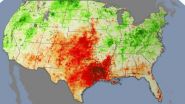(Press-News.org)
VIDEO:
This new global view and animation of Earth’s city lights is a composite assembled from data acquired by the Suomi NPP satellite. The data was acquired over nine days in...
Click here for more information.
Scientists unveiled today an unprecedented new look at
our planet at night. A global composite image, constructed using
cloud-free night images from a new NASA and National Oceanic and
Atmospheric Administration (NOAA) satellite, shows the glow of
natural and human-built phenomena across the planet in greater detail
than ever before.
Many satellites are equipped to look at Earth during the day, when
they can observe our planet fully illuminated by the sun. With a new
sensor onboard the NASA-NOAA Suomi National Polar-orbiting
Partnership (NPP) satellite launched last year, scientists now can
observe Earth's atmosphere and surface during nighttime hours.
The new sensor, the day-night band of the Visible Infrared Imaging
Radiometer Suite (VIIRS), is sensitive enough to detect the nocturnal
glow produced by Earth's atmosphere and the light from a single ship
in the sea. Satellites in the U.S. Defense Meteorological Satellite
Program have been making observations with low-light sensors for 40
years. But the VIIRS day-night band can better detect and resolve
Earth's night lights.
The new, higher resolution composite image of Earth at night was
released at a news conference at the American Geophysical Union
meeting in San Francisco. This and other VIIRS day-night band images
are providing researchers with valuable data for a wide variety of
previously unseen or poorly seen events.
"For all the reasons that we need to see Earth during the day, we also
need to see Earth at night," said Steve Miller, a researcher at
NOAA's Colorado State University Cooperative Institute for Research
in the Atmosphere. "Unlike humans, the Earth never sleeps."
The day-night band observed Hurricane Sandy, illuminated by moonlight,
making landfall over New Jersey on the evening of Oct. 29. Night
images showed the widespread power outages that left millions in
darkness in the wake of the storm. With its night view, VIIRS is able
to detect a more complete view of storms and other weather
conditions, such as fog, that are difficult to discern with infrared,
or thermal, sensors. Night is also when many types of clouds begin to
form.
"The use of the day-night band by the National Weather Service is
growing," said Mitch Goldberg, program scientist for NOAA's Joint
Polar Satellite System. For example, the NOAA Weather Service's
forecast office in Monterey, Calif., is now using VIIRS day-night
band images to improve monitoring and forecasting of fog and low
clouds for high air traffic coastal airports like San Francisco.
According to Goldberg, VIIRS images were used on Nov. 26, the Monday
after Thanksgiving, to map the dense fog in the San Francisco Bay
area that resulted in flight delays and cancellations.
Unlike a camera that captures a picture in one exposure, the day-night
band produces an image by repeatedly scanning a scene and resolving
it as millions of individual pixels. Then, the day-night band reviews
the amount of light in each pixel. If it is very bright, a low-gain
mode prevents the pixel from oversaturating. If the pixel is very
dark, the signal is amplified.
"It's like having three simultaneous low-light cameras operating at
once and we pick the best of various cameras, depending on where
we're looking in the scene," Miller said. The instrument can capture
images on nights with or without moonlight, producing crisp views of
Earth's atmosphere, land and ocean surfaces.
"The night is nowhere as dark as we might think," Miller said. And
with the VIIRS day-night band helping scientists to tease out
information from human and natural sources of nighttime light, "we
don't have to be in the dark anymore, either."
"The remarkable day-night band images from Suomi NPP have impressed
the scientific community and exceeded our pre-launch expectations,"
said James Gleason, Suomi NPP project scientist at NASA's Goddard
Space Flight Center in Greenbelt, Md.
INFORMATION:
For images and additional information, visit:
http://www.nasa.gov/mission_pages/NPP/news/earth-at-night.html
NASA-NOAA satellite reveals new views of earth at night
2012-12-06
ELSE PRESS RELEASES FROM THIS DATE:
New report finds increase in media coverage of synthetic biology
2012-12-06
WASHINGTON – Press coverage of synthetic biology in the United States and Europe increased significantly between 2008 and 2011, according to a report released today by the Synthetic Biology Project at the Woodrow Wilson International Center for Scholars.
The report, Trends in American and European Press Coverage of Synthetic Biology: 2008 – 2011, builds on the project's earlier study of US-EU press coverage between 2003 and 2008. Synthetic biology, an area of research focused on the design and construction of new biological parts and devices, or re-design of existing ...
Synthetic fuel could eliminate US need for crude oil
2012-12-06
The United States could eliminate the need for crude oil by using a combination of coal, natural gas and non-food crops to make synthetic fuel, a team of Princeton researchers has found.
Besides economic and national security benefits, the plan has potential environmental advantages. Because plants absorb carbon dioxide to grow, the United States could cut vehicle greenhouse emissions by as much as 50 percent in the next several decades using non-food crops to create liquid fuels, the researchers said.
Synthetic fuels would be an easy fit for the transportation system ...
New '4-D' transistor is preview of future computers
2012-12-06
WEST LAFAYETTE, Ind. – A new type of transistor shaped like a Christmas tree has arrived just in time for the holidays, but the prototype won't be nestled under the tree along with the other gifts.
"It's a preview of things to come in the semiconductor industry," said Peide "Peter" Ye, a professor of electrical and computer engineering at Purdue University.
Researchers from Purdue and Harvard universities created the transistor, which is made from a material that could replace silicon within a decade. Each transistor contains three tiny nanowires made not of silicon, ...
NASA satellites analyze Typhoon Bopha inside and out
2012-12-06
Typhoon Bopha proved deadly to residents in the Mindanao region of the Philippines after ravaging islands in Micronesia. NASA's Aqua and TRMM satellites peered at the storm inside and out, providing forecasters with valuable data as the storm moved into the South China Sea.
On Dec. 5, 2012, Bopha crossed over Palawan and entered the South China Sea after crossing over the southern Philippines' Mindanao region, leaving death and destruction in its wake. According to Reuters news reports on Dec. 5, at least at total of 283 people were killed and hundreds remain missing ...
Plant stress paints early picture of drought
2012-12-06
In July 2012, farmers in the U.S. Midwest and Plains regions watched crops wilt and die after a stretch of unusually low precipitation and high temperatures. Before a lack of rain and record-breaking heat signaled a problem, however, scientists observed another indication of drought in data from NASA and NOAA satellites: plant stress.
Healthy vegetation requires a certain amount of water from the soil every day to stay alive, and when soil moisture falls below adequate levels, plants become stressed. Scientists with the U.S. Department of Agriculture's Agricultural Research ...
NASA investigates use of 'trailblazing' material for new sensors
2012-12-06
Tiny sensors -- made of a potentially trailblazing material just one atom thick and heralded as the "next best thing" since the invention of silicon -- are now being developed to detect trace elements in Earth's upper atmosphere and structural flaws in spacecraft.
Technologist Mahmooda Sultana, who joined NASA's Goddard Space Flight Center in Greenbelt, Md., two years ago and has since emerged as Goddard's go-to expert in the development of graphene-based technology, has expanded her portfolio to include two new research and development efforts aimed at creating nano-sized ...
Site-specific, long-term research expanding understanding of climate change
2012-12-06
DURHAM, N.H., Dec. 5, 2012 – While science has often focused on big-scale, global climate change research, a study recently published in the journal Bioscience suggests that long-term, integrated and site-specific research is needed to understand how climate change affects multiple components of ecosystem structure and function, sometimes in surprising ways.
"Long-term ecological research is important to understanding the effects of a changing climate on our natural resources and so much more," said Michael T. Rains, Director of the Forest Service's Northern Research Station. ...
Experts available to discuss new paper detailing global sea level rise scenario
2012-12-06
On December 6, NOAA will release a technical report that estimates global mean sea level rise over the next century based on a comprehensive synthesis of existing scientific literature. The report finds that there is very high confidence (greater than 90% chance) that global mean sea level will rise at least 8 inches (0.2 meters) and no more than 6.6 feet (2 meters) by 2100, depending upon uncertainties associated with ice sheet loss and ocean warming.
The actual amount of sea level change at any one region and location greatly varies in response to regional and local ...
Biologists unlocking the secrets of plant defenses, 1 piece at a time
2012-12-06
Researchers examining how the hormone jasmonate works to protect plants and promote their growth have revealed how a transcriptional repressor of the jasmonate signaling pathway makes its way into the nucleus of the plant cell.
They hope the recently published discovery will eventually help farmers experience better crop yields with less use of potentially harmful chemicals.
"This is a small piece of a bigger picture, but it is a very important piece," said Maeli Melotto, a University of Texas at Arlington assistant professor of biology.
Melotto recently co-authored ...
Military/Veteran Medical Malpractice Claims Are An Uphill Battle
2012-12-06
Military/Veteran medical malpractice claims are an uphill battle
Some of the highest courts in the land -- the United States Supreme Court among them -- will soon be hearing cases involving the niche area of military malpractice claims. Military physicians usually enjoy "sovereign immunity" (essentially making them immune from many types of lawsuits) in their capacity as physicians working for the government.
These cases do not argue the validity of sovereign immunity, but instead question its applicability in even the most egregious military medical malpractice ...




